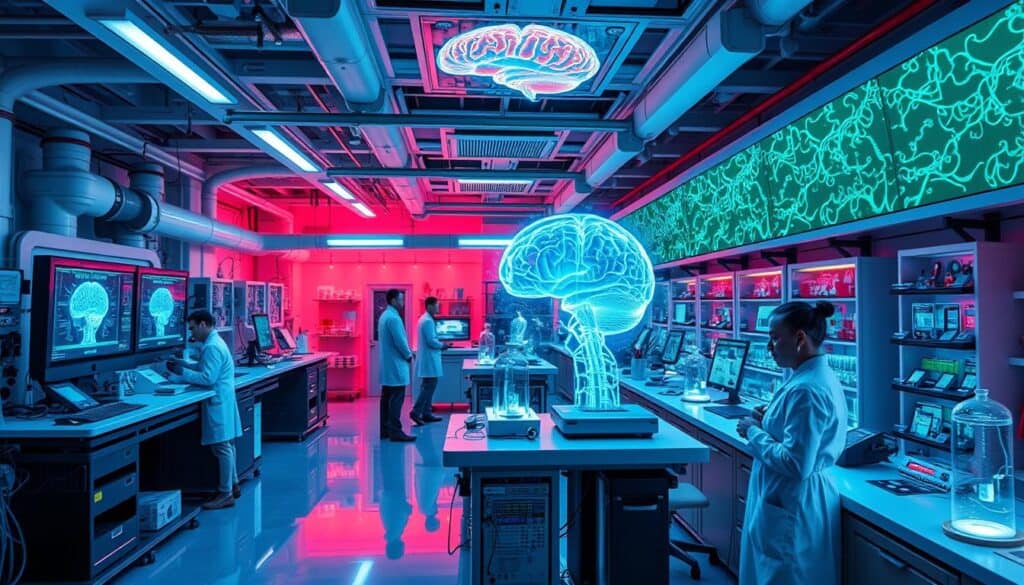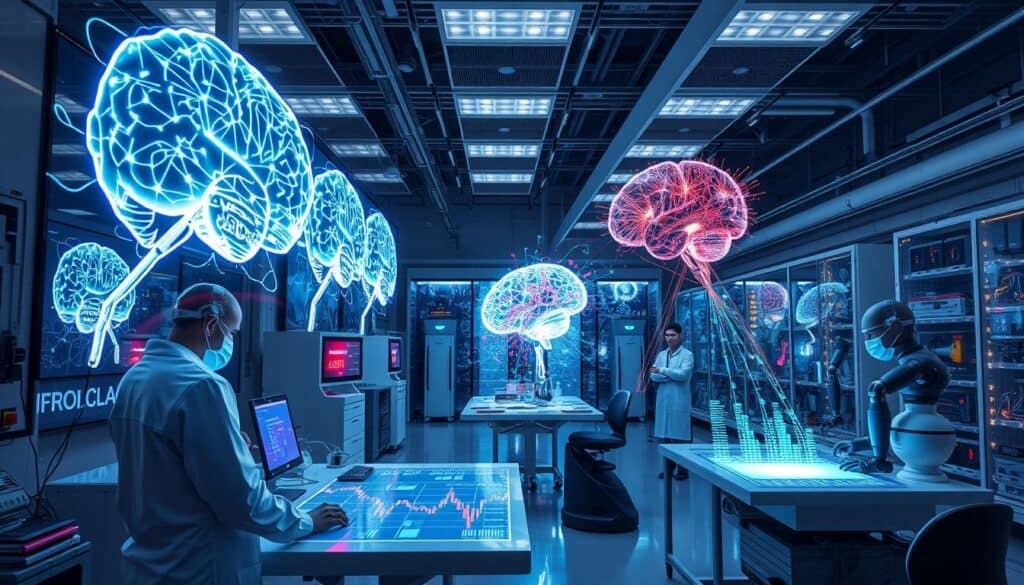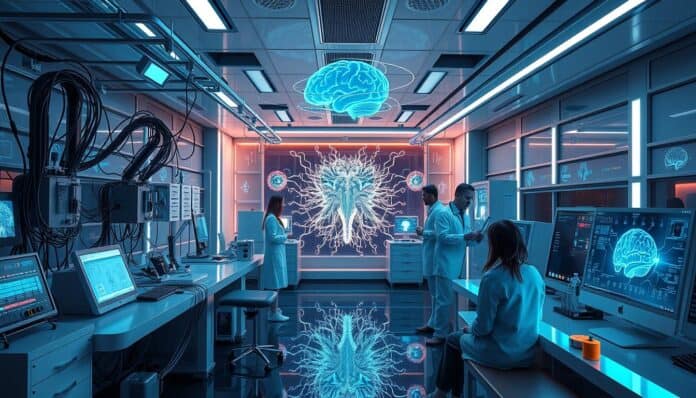Did you know that in 2024, biotechnology research funding is expected to hit $9,137 million? This huge investment shows the importance of neural engineering. It combines many scientific fields to improve how we understand and control neural activities. This field is not only about getting funds. It’s about making big strides in brain-computer connections, changing treatments for brain disorders, and how we interact with machines.
Neural engineering is leading the way in medical research by merging bioengineering, brain science, and digital tech. In 2024, this field is pushing the limits of our knowledge and capabilities. For example, a few patients have received BCIs directly implanted into their brains. But, over 160,000 people have used deep brain stimulation devices to handle brain conditions.
Wichtigste Erkenntnisse
- Neural engineering in 2024 benefits from significant funding across various research domains, including biotechnology and bioengineering.
- Brain-computer interfaces and neuromodulation techniques are at the forefront of current research trends.
- Noninvasive BCIs using EEG are emerging technologies with promise, facing challenges in signal extraction.
- Institutions like Harvard are actively seeking experts in the field to drive forward innovative research.
- Advancements in artificial intelligence and machine learning are set to enhance BCI performance and reliability.
Overview of Neural Engineering in 2024
Neural engineering in 2024 stands at the crossroads of Innovation and major healthcare advancements. It combines computer science, electrical engineering, and more to make devices that work with brain tissue. The field’s wide applications, like brain-computer links, neuroimaging, and robot-assisted motion, highlight its game-changing potential.
Definition and Scope
Neural engineering uses engineering to understand and improve the nervous system. It helps fix severe issues like strokes and brain injuries and enhances the control over robots. This field is making strides in turning brain activity into tech solutions, improving how we move and perceive the world.
Historical Context and Evolution
The field of neural engineering has grown from basic neuromodulation devices to complex brain-computer links. A key focus now is on making tissues that can heal nerves. Animal studies have been crucial for grasping human brain pathways, setting the stage for today’s neural engineering feats in 2024.
Also, lasting neural recording systems have changed how we view and control neural signals. Devices that help restore movement after strokes showcase the field’s real-world impact. And the field keeps growing, holding promise for new ways to augment human abilities.
| Field | Anmeldung | Auswirkungen |
|---|---|---|
| Brain-Computer Interfaces | Control robotic devices, improve neuroprostheses | Expanded human-technology interaction |
| Neuroimaging | Advanced brain mapping techniques | Better understanding of brain functions |
| Neural Tissue Engineering | Nerve repair and regeneration | Improved recovery post-neural injuries |
| Neurorobotics | Enhanced robotic limb control | Improved quality of life for amputees |
Current Trends in Neural Engineering Research
In 2024, neural engineering is making big strides in science and tech. It’s all about new breakthroughs that mix different fields of study. We’re seeing better neural interfaces, brain-computer setups, and new ways to change nerve activity. These advancements are changing medicine and deepening our knowledge of the brain and nerves.
Neural Interfaces and Brain-Computer Interfaces
Right now, neural interfaces and brain-computer interfaces (BCIs) are leading the way. They’ve gotten better thanks to new materials and building techniques. This means they’re less invasive and work better with our neurological systems. BCIs are especially important for helping people with severe movement issues communicate and control devices.
Neuromodulation and Neuroprostheses
Neuromodulation and neuroprosthetics are getting a lot of attention too. Techniques like deep brain stimulation help with Parkinson’s and epilepsy. Neuroprosthetics are improving or replacing nervous system functions. The focus is on precise control and making them fit each patient better. This could lead to better health outcomes and more options for treatment.
Emerging Technologies and Innovations
Linking neural engineering with AI and machine learning is a big trend. This makes neural devices smarter and able to adjust on their own. They offer better feedback and can process data in real-time. Exciting work with nanotech and CRISPR-Cas9 also shows where we could be headed next. These could change how we diagnose and treat neurological ailments.
Moreover, there’s work on sophisticated neural interfaces that mesh well with our bodies. This points to a research field that’s always looking forward. It’s a hopeful sign that neural engineering could transform health care and boost human abilities.
Key Companies Leading Neural Engineering in 2024
In 2024, established companies and innovative startups are making big strides in neural engineering. They are focusing on neural interfaces, neuromodulation, and neuroprostheses. Their work is changing how we think about the future of these technologies.
Main Players in the Market
Big companies have been leading the charge in neural engineering. They’re innovating and developing new technologies:
- Boston Scientific: They are leaders in creating minimally invasive devices. Their Greenlight system treats benign prostate hyperplasia effectively.
- Medtronic: Investing heavily in R&D, Medtronic makes devices like cardiac pacemakers and neurostimulation systems. They focus on advanced tools that require less invasive surgeries.
- GE Healthcare: They specialize in diagnostic imaging like MRI, CT, and ultrasound. GE Healthcare is dedicated to improving patient care with these technologies.
- Abbott: Known for their diagnostic products, Abbott is improving the management of diabetes, heart conditions, and more. Their work significantly impacts healthcare technology.
- Stryker: Stryker is advancing surgical procedures and orthopedic treatments. They design medical devices that support these improvements.

Startups and New Entrants
New companies are also bringing fresh ideas to neural engineering. They’re developing new solutions and getting the funding they need:
- Blackrock Neurotech: They got $200 million from Tether in April 2024. Blackrock is making big advancements in neural interfaces.
- Verge Genomics: With $134.1 million in Series B funding, they’re tackling neurodegenerative diseases. This makes them a key player in neural engineering.
- Ceribell: They’ve seen an impressive growth rate over five years. Ceribell is maintaining its growth in the neural engineering field.
- Neuralink: Valued at $5 billion after getting $280 million in funding. Neuralink is working on brain-machine interfaces that could change neural engineering.
- Hippoc: This Montreal startup got $3 million in seed funding. They’re mixing neuroscience and AI for groundbreaking innovations.
The global neuroscience market is expected to hit $721 billion by 2026. A 4.2% growth rate is fueling this trend. With continued investments, we’ll see more jobs and innovations in neural engineering.
The biomedical engineering field is geführt by companies like Boston Scientific and Medtronic. They’re at the forefront of medical tech advancements. These companies are key to better healthcare through new devices and technologies.
| Company | Notable Achievement |
|---|---|
| Blackrock Neurotech | Raised $200M from Tether; majority stake acquisition |
| Verge Genomics | Secured $134.1M Series B funding |
| Ceribell | 7,592% search growth rate over five years |
| Neuralink | $5B valuation after $280M funding |
| Hippoc | $3M seed funding for neuroscience and AI platform |
Both established companies and new players are shaping neural engineering’s future. Their innovations offer promising job prospects. These advancements will push healthcare into new territories.
Practical Applications of Neural Engineering in 2024
Neural engineering is doing big things in 2024. It’s changing many parts of our lives and health, thanks to new tech. Medical areas and beyond are seeing huge improvements.
Medical and Therapeutic Uses
Neural engineering is making a mark in medicine. The IEEE Brain Workshop in Chicago will show off these advances. It is all set for October 3-4, 2024, focusing on new therapies and their impacts.
Neuroprosthetics are a game-changer, fixing sight, hearing, and movement. Optogenetics is also fighting Parkinson’s and epilepsy. A big team of experts is joining forces to tackle medical hurdles with neural engineering in 2024.
| Medical Challenge | Neural Engineering Application |
|---|---|
| Neurological Disorders | Optogenetics-based therapies |
| Motor Function Restoration | Neuroprosthetics |
| Vision and Hearing Loss | Advanced Neuroprosthetics |
Non-Medical Applications
Neural engineering isn’t just for medicine. It’s also boosting non-medical fields. Things like brain-computer interfaces (BCIs) are getting better, thanks to it.
This tech is making it easier to dive into virtual worlds. It’s opening new doors in gaming, learning, and VR. Dr. Amy Kruse from Satori Neuro will talk about these leaps at the IEEE Symposium.
In 2024, neural engineering’s reach is impressive. It’s mixing new technologies with cool applications. This mix is set to greatly boost what humans can do.
Future Advancements in Neural Engineering
Future advancements in neural engineering will deeply change how we interact with technology. Over 50 scholarly articles were reviewed, showing that the field is quickly evolving. These articles discuss various topics. For example, brain-computer interfaces, neuroprosthetic implants, and methods for modeling neurological diseases. They also talk about deep brain stimulation and devices that can control epilepsy.

Projected Technological Breakthroughs
In 2024, big breakthroughs in neural engineering are expected. The reviewed literature highlights technologies like the BrainGate implant and DARPA’s brain-computer project. There are also new methods for detecting neurotransmitters. Innovations such as neural tissue for treating spinal cord injuries and visual aids for the blind are on the horizon.
Companies like Medtronic PLC are at the forefront, offering treatments for many medical conditions worldwide. They are making advances in bionics and prosthetics. This includes improved limbs, Cochlear implants, and retinal implants that use new tech.
Potential Impact on Society
These advancements will have a big impact on society. Brain-computer interfaces (BCIs), like ECoG or EEG, are helping people with many conditions. Successful collaborations between experts are key to these technologies.
Ethics and societal impact are also important to consider. Topics like the safety of implant electrodes and privacy are being discussed. Successful cases have already improved many lives. For example, bionic reconstruction after nerve injury and prosthetic arms for arm loss have been transformative.
The table below summarizes some of the key advancements and their impacts:
| Advancement | Key Contributor | Auswirkungen |
|---|---|---|
| BrainGate Implant | Medtronic PLC | Restoration of movement for paralytic patients |
| Visual Neuroprosthesis | Cochlear | Vision restoration for the blind |
| Neural Tissue Transplantation | Various research institutions | Spinal cord injury treatment |
| Neuroprotheses | Ekso Bionics, Ossur | Enhanced prosthetic limb functionality |
Diese future advancements in neural engineering in 2024 are set to break new ground. They bring new hope and possibilities for millions worldwide in both medicine and technology.
Opportunities in Neural Engineering
The field of neural engineering is growing fast. It offers great careers and learning opportunities. Schools and research places are creating new programs for this demand.
Career Prospects and Educational Pathways
Jobs in neural engineering vary widely, from schools to high-tech firms. Now, many colleges offer degrees in neural engineering and related fields. A standout program is at Georgia Tech and Emory University. It blends neuroscience, engineering, and medicine.
It gets support from the NIH and other funding. This mix of studies prepares students for the future.
| Institution | Program | Application Deadline |
|---|---|---|
| University of Washington | Research Experience for Undergraduates | January 15, 2025 |
| Georgia Tech | Undergraduate Research in Engineering/Sciences | February 15, 2025 |
| Neuromatch Academy | Open Science 101 Course | K.A. |
| Georgia Tech & Emory University | Computational Neural-Engineering Training Program | Rolling |

Funding and Grants
The NIH now gives 50% more support to neural engineering programs. This boost helps Georgia Tech and Emory University grow their program. More students can now get help with fees and gain knowledge and skills.
Other funds come from the National Science Foundation (NSF) and its workshops. These efforts give students a broad and deep education. They’re ready to tackle today’s neural engineering challenges.
The Impact of Neural Engineering in 2024
Neural engineering, as we know it in 2024, has changed our world. It has reshaped healthcare, impacting the economy and how we live. Through advanced biotech, innovative diagnostic tools, and new treatments, it brings major changes.
Healthcare Improvements
Neural engineering has led to huge steps forward in healthcare. One example is how researchers at Michigan State University study early brain development. This research helps spot disorders like autism and ADHD earlier than before.
Research at MSU also found that honeybees can sniff out lung cancer signs in breath. This breakthrough in diagnostics is changing patient care. It allows doctors to find diseases sooner and improve treatment success.

Economic and Social Impacts
The economic effects of neural engineering in 2024 are big. This growing sector sparks innovation, creates jobs, and opens new markets. For instance, two MSU Biomedical Engineering students were recognized for their research. This shows the need for more education programs to build a skilled workforce.
| Healthcare Advancements | Economic Contributions |
|---|---|
| Improved diagnostic techniques (e.g., honeybee biomarker detection) | Job creation and innovation in biomedical sectors |
| Advanced treatments for neurological disorders | Market opportunities for new medical devices and technologies |
Neural engineering’s societal impact has stirred deep ethical discussions. The idea of human enhancement through bioengineering poses serious questions. For example, Rebecca Knickmeyer studies genetics in brain development, highlighting future shifts in how we view neurological conditions.
In summary, neural engineering changes healthcare, economy, and societal norms. As we move forward, balancing tech advancements with ethical concerns is key. We must make sure these innovations are good for everyone.
Challenges and Ethical Considerations
The field of neural engineering is rapidly growing. It faces many challenges and ethical issues. We must solve these problems for the field to move forward responsibly.
Ethical Dilemmas in Neural Engineering
One major ethical consideration in neural engineering is the debate between enhancement and therapy. Devices like brain-computer interfaces can help with conditions like epilepsy, Parkinson’s disease, and loss of communication. But, their use for making people “better than well” brings up issues of privacy and fairness.
There are also concerns about making people all think similarly, being inauthentic, and devaluing achievements. Informed consent is critical to let people know the risks and possible dangers. Past issues with medical devices highlight the need for strict ethical standards.
Technical and Practical Challenges
Die challenges in neural engineering go beyond just ethical concerns. Technical issues also stand in the way. Brain-computer interfaces need to record many neurons and need better electrodes and materials to do this well. The complexity of the human nervous system makes creating effective treatments hard.
Our knowledge of the brain is still limited. This makes it tough to improve and fine-tune neural interfaces. Invasive interfaces need surgery, while noninvasive ones use wearable devices. Both have unique challenges that require more research and innovation.
| Key Challenges | Beispiele |
|---|---|
| Ethical Dilemmas | Privacy concerns, inequality, informed consent |
| Technical Challenges | Improving electrode design, recording sufficient neurons |
| Practical Implementation | Integration within complex nervous systems |
It’s crucial to tackle these challenges and ethical issues as neural engineering grows. This ensures its responsible and sustainable development.
Schlussfolgerung
Neural engineering is advancing rapidly as of 2024. It’s creating new chances and tough choices for us. We see big steps forward in tech like neural and brain-computer interfaces, and in treating or replacing parts of the nervous system. Spiking Neural Networks (SNNs) are now competing with Deep Neural Networks (DNNs). They are making waves in space and cars, among others.
This field isn’t just changing health care. It could change our economies and how we live together. New ideas like Meta-SpikePropamine and Chip-In-Loop SNN Proxy Learning show the field’s energy. There’s a growing interest in tech that senses events and in neuromorphic engineering. For these ideas to help society, we need teamwork across fields and smart rules.
Conferences like The Brain and The Chip 2024 are key. They set high standards and share big ideas, shaping the future of neural engineering. The dedication of places like the University Miguel Hernández in Elche is vital. They ensure top-notch education and research in this exciting area. Neural engineering’s future is bright, but it needs us to work together—academics, companies, and governments.
FAQ
What is the current status of neural engineering research and applications in 2024?
In 2024, neural engineering is leading the way in medical science. It combines bioengineering, brain studies, and digital tech. The goal is to understand and control how the brain works. This area works on fixing nervous system problems and improving how humans and machines interact. It uses new materials science and tiny manufacturing technologies.
How has neural engineering evolved historically?
Neural engineering has grown from simple devices to advanced brain-computer links. It now works to improve and restore human abilities. This is done by turning brain activity into useful actions and back. It uses expertise from computer brain studies, electrical studies, and other fields.
What are the current trends in neural engineering research?
The latest trends in this field include better neural links and computer-brain interfaces, new ways to control brain activity, artificial limbs, and cutting-edge technology in materials and tiny manufacturing. These improvements aim for less invasive, more effective ways to connect with the human brain.
Who are the key companies leading neural engineering in 2024?
Both big companies and new startups are key players in neural engineering. Big firms push forward research on neural links. Startups bring new ideas and get venture capital to make a mark in the sector.
What are the practical applications of neural engineering in 2024?
Neural engineering has many uses, from medical treatments for diseases like Parkinson’s and epilepsy to non-medical purposes. It helps improve how we process information and interact with digital worlds. These uses show its Vielseitigkeit and huge potential.
What future advancements are expected in neural engineering?
Future breakthroughs in neural engineering will change how we interact with technology. Expect better brain-computer interfaces and devices that can adjust brain activity. These will make the line between human thought and machines even fuzzier.
What opportunities exist for careers in neural engineering?
There are many job chances in neural engineering, in academic research, and tech companies focused on learning machines and smart intelligence. Many universities now offer special courses and degrees. They are often supported by grants from big science funds.
How does neural engineering impact healthcare in 2024?
Neural engineering is improving healthcare with better diagnosis and care through advanced biotechnologies and treatments. It’s driving innovation, creating jobs, and opening new markets. But it also brings up big ethical questions about human enhancement.
What are the main challenges and ethical considerations in neural engineering?
This field faces big challenges, including ethical issues about privacy, agreeing to treatment, and the line between making people better and therapy. The complexity of the brain makes finding effective treatments hard. This requires teamwork across many fields and careful rules.


It’s fascinating to see neural engineering pushing both medical and non-medical boundaries
the article could delve deeper into the societal implications of these technologies, such as potential shifts in employment
It would be interesting to explore ethical considerations and potential risks associated with these